“Philosophies are six, viz., systems of Kanada, Aksapada (Gotama), Vyasa, Kapila, Patanjali and Jaimini”. These are respectively called, Vaisesika, Nyaya, Vedanta, Samkhya, Yoga and Mimamsa. Nobody knows who first originated the tradition of grouping these six as the six Hindu philosophies, Sat Darsana. The first book which enumerates them thus seems to be the Visvasaratantra, believed to be written in the twelfth century, A.D. Madhava’s famous book describes many other Hindu systems of philosophy besides these six. Jayanta, a great writer on Nyaya and who belonged to a family of Minamsakas, mentions the following as what he calls the six logics or theories, Sat Tarki; Mimamasa, Nyaya, Samkhya, Jaina, Bauddha and Carvaka. Jayanta is reported to have lived in the tenth century, and it is curious that Yoga and Vendanta do not find a place in his list as well as that of Haribhadra, which proves that the omission of them by Haribhadra was not due to any prejudice.
This also means that even by the tenth century it has not become the fashion to refer to Vaisesika, Nayaya, Samkhya, Yoga, Mimamasa and Vednta only the systems. Jaina and Bauddha philosophies invariably found their places in any such enumeration of six systems. The Justification for the omission of Yoga was perhaps that it was only a spiritual discipline, which to a large extent borrowed its metaphysics from Samkhya while Vedanta was omitted probably because it was considered to be nothing but the application of Mimamsa rules of interpretation to the Upanisads. Thus, it is in a sense theology.
Whatever might be the reason, Yoga and Vedanta find no place in Haribhadra’s Compendium, and this is regrettable as one of them has become the dominant philosophy of India.
I have thought it useful to translate Haribhadra’s Compendium into English, because it is shorter in compass than Madhava’s books, but mentions in brief all the important points in connection with each system. It also avoids descriptions of semi philosophical systems as Rasa-vada and purely religious philosophies such as Nakulisa-pasupata. He gives objective accounts of all the philosophies and attempts no criticism of any of them; except that while describing his own philosophical faith he, begins by saying that it is a “well thought-out one” and ends by concluding that it is entirely free from self-contradiction. I thick students of Indian philosophy in our universities will profit a great deal by reading the works of Madhava and Haribhadra, alongside the standard modern works of Radhakrishnan and Das Gupta.
Manibhadra has written a commentary on this work and both the original and the commentary were published in the Chowkhamba Sanskrit Series of Banaras (1905); and a second edition came out in 1919. Unfortunately, no details seem to be available about Manibhadra except that he too was a Jaina, with a surprising catholicity of mind. I have freely drawn upon this illuminating commentary in the writing of my Notes.
There is another commentary on this book by Gunaratna. Unlike Manibhadra’s, it explains in great detail every system. Along with the text, it has been edited by Luigi Suali of Bologna and published by the Calcutta Asiatic Society in 1905.
Suali has edited the text basing himself upon an old and carefully written manuscript in the Berlin University Library and another belonging to Hermann Jacobi. The Banaras edition is based upon two manuscripts – One from Jaipur and the other belonging to Madan Gopal Library of Brindavan.
Manibhadra’s text differs at some places from Gunaratna’s: but these variations are few and unimportant. Except in a few cases, I have usually followed Manibhara’s readings.
Professor Ram Murti Sharma, Ph. D. Litt., Professor of Sanskrit, Panjab University, Chandigarh has helped in editing the text and correcting the proofs, etc. I appreciate his help and am grateful to him. I am glad that my translation of this classic is being republished by Messers Eastern Book Linkers, Delhi-7.
Dipavali, 1957.



